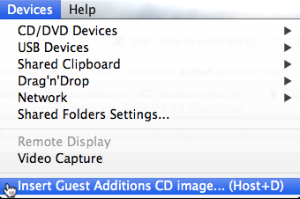| Section | |||||||||||||||||||||||||||||||||||||||||
|---|---|---|---|---|---|---|---|---|---|---|---|---|---|---|---|---|---|---|---|---|---|---|---|---|---|---|---|---|---|---|---|---|---|---|---|---|---|---|---|---|---|
|
...
- Start up the virtual machine (VM) and let it start up fully.
First On the virtual machine (not the host), check that the necessary kernel files are installed:
Code Block zypper search kernel-devel
If not, install them with the command:
Code Block sudo zypper install kernel-devel
The installation needs to be done as the root user. This command will prompt for the root password '
metv1ew!'The 'make' and 'gcc' packages are also required but these are normally available by default in the OpenIFS virtual machine.
- With the virtual machine as the active window, select the 'Devices' menu and the 'Install guest additions CD image..
A popup window should appear in the virtual machine showing the CD.
Click the Guest Additions CD to mount it. A new folder window should appear showing the contents of the CD. - In the virtual machine, open a Terminal window from the openSUSE icon and 'Applications' menu
In the Terminal, change to the directory where the VBoxAdditions CD was mounted. This will be under the /run/media directory, followed by the username.
Code Block title e.g. cd /run/media/openifs/VBOXADDITIONS_4.3.34_104062
(older systems may use /var/run/media instead).
To start the installation of the Guest Additions, type the following in the Terminal:
Code Block sudo ./VBoxLinuxAdditions.run
This will prompt for the root password, usually
'metv1ew!'Info The installation may report that Guest Additions is already installed and ask you to confirm.
The installation only takes a few minutes.
- Reboot the virtual machine for the changes to take effect.
...
For the 2015 and later OpenIFS workshops, download the latest version of the OpenIFS/Metview virtual machine (contact openifs-support@ecmwf.int for assistance).
Configure the virtual machine as above and let is start fully. Then:
...
If shared folder does not automatically mount
Mount On the virtual machine, mount the folder manually by (for example to your home directory):
...
If a system update has updated the kernel files and shared folders have stopped working, reinstall the Guest Additions software. Guest Additions adds files to the kernel and these must be reinstalled if the kernel is changed.
| Excerpt Include | ||||||
|---|---|---|---|---|---|---|
|


